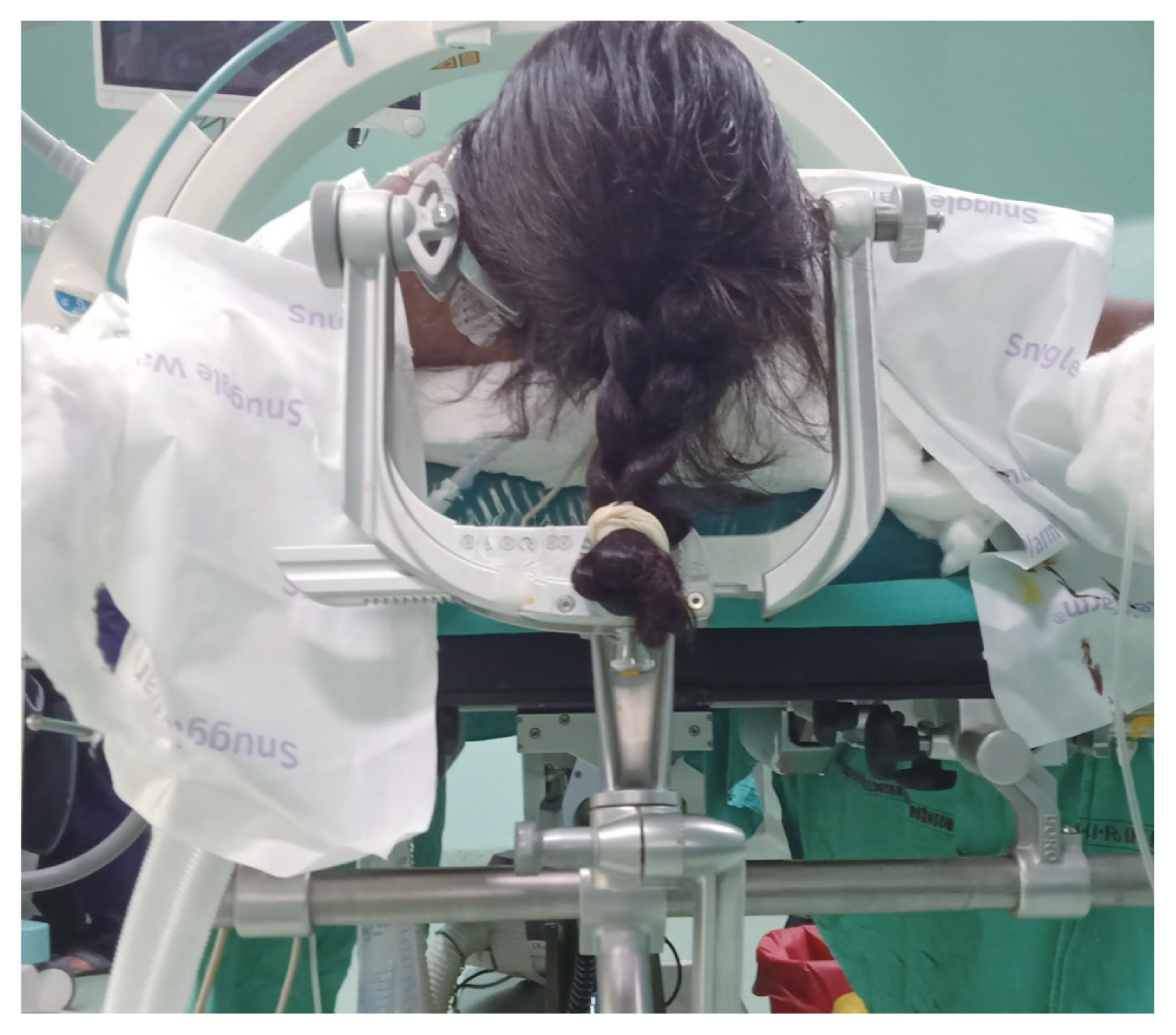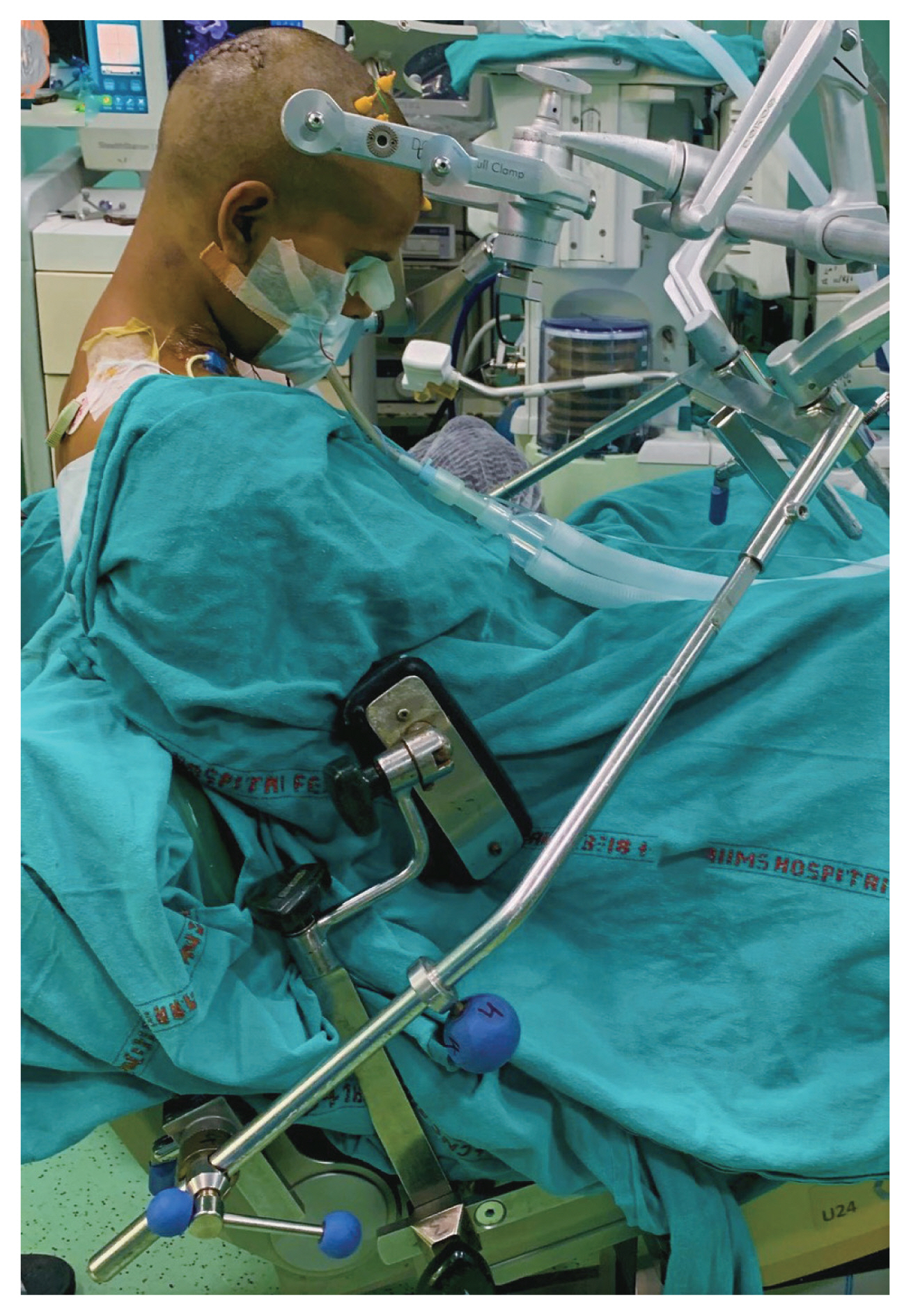1. Deyo RA, Gray DT, Kreuter W, Mirza S, Martin BI. United States trends in lumbar fusion surgery for degenerative conditions. Spine (Phila Pa 1976) 2005;30:1441–7.


2. Oglesby M, Fineberg SJ, Patel AA, Pelton MA, Singh K. Epidemiological trends in cervical spine surgery for degenerative diseases between 2002 and 2009. Spine (Phila Pa 1976) 2013;38:1226–32.


3. Kutteruf R, Wells D, Stephens L, Posner KL, Lee LA, Domino KB. Injury and liability associated with spine surgery. J Neurosurg Anesthesiol 2018;30:156–62.


5. De la Garza-Ramos R, Samdani AF, Sponseller PD, et al. Visual loss after corrective surgery for pediatric scoliosis: incidence and risk factors from a nationwide database. Spine J 2016;16:516–22.


6. Nandyala SV, Marquez-Lara A, Fineberg SJ, Singh R, Singh K. Incidence and risk factors for perioperative visual loss after spinal fusion. Spine J 2014;14:1866–72.


7. Chang SH, Miller NR. The incidence of vision loss due to perioperative ischemic optic neuropathy associated with spine surgery: the Johns Hopkins Hospital Experience. Spine (Phila Pa 1976) 2005;30:1299–302.

8. Patil CG, Lad EM, Lad SP, Ho C, Boakye M. Visual loss after spine surgery: a population-based study. Spine (Phila Pa 1976) 2008;33:1491–6.

9. Shillingford JN, Laratta JL, Sarpong NO, et al. Visual loss following spine surgery: what have we seen within the scoliosis research society morbidity and mortality database? Spine (Phila Pa 1976) 2018;43:1201–7.

11. Goyal A, Elminawy M, Alvi MA, et al. Ischemic optic neuropathy following spine surgery: case control analysis and systematic review of the literature. Spine (Phila Pa 1976) 2019;44:1087–96.

13. Dunker S, Hsu HY, Sebag J, Sadun AA. Perioperative risk factors for posterior ischemic optic neuropathy. J Am Coll Surg 2002;194:705–10.

14. Greenway F, Tulloch I, Laban J. Consent for post-operative visual loss in prone spinal surgery: aligning clinical practice with legal standards. Br J Neurosurg 2018;32:604–9.


15. Carey TW, Shaw KA, Weber ML, DeVine JG. Effect of the degree of reverse Trendelenburg position on intraocular pressure during prone spine surgery: a randomized controlled trial. Spine J 2014;14:2118–26.


16. Jeon YT, Park YO, Hwang JW, Lim YJ, Oh YS, Park HP. Effect of head position on postoperative chemosis after prone spinal surgery. J Neurosurg Anesthesiol 2007;19:1–4.


17. Fandino W. Strategies to prevent ischemic optic neuropathy following major spine surgery: a narrative review. J Clin Anesth 2017;43:50–8.


18. Cheney FW, Domino KB, Caplan RA, Posner KL. Nerve injury associated with anesthesia: a closed claims analysis. Anesthesiology 1999;90:1062–9.


19. Coppieters MW, Van de Velde M, Stappaerts KH. Positioning in anesthesiology: toward a better understanding of stretch-induced perioperative neuropathies. Anesthesiology 2002;97:75–81.

22. Sherman CE, Rose PS, Pierce LL, Yaszemski MJ, Sim FH. Prospective assessment of patient morbidity from prone sacral positioning. J Neurosurg Spine 2012;16:51–6.


23. Gelberman RH, Yamaguchi K, Hollstien SB, et al. Changes in interstitial pressure and cross-sectional area of the cubital tunnel and of the ulnar nerve with flexion of the elbow: an experimental study in human cadavera. J Bone Joint Surg Am 1998;80:492–501.


25. Kamel IR, Drum ET, Koch SA, et al. The use of somatosensory evoked potentials to determine the relationship between patient positioning and impending upper extremity nerve injury during spine surgery: a retrospective analysis. Anesth Analg 2006;102:1538–42.


26. Uribe JS, Kolla J, Omar H, et al. Brachial plexus injury following spinal surgery. J Neurosurg Spine 2010;13:552–8.


27. Ben-David B, Stahl S. Prognosis of intraoperative brachial plexus injury: a review of 22 cases. Br J Anaesth 1997;79:440–5.


28. Daniels AH, Deodhar AA, Hart RA. Traumatic spondyloptosis resulting from high-energy trauma concurrent with a tonic-clonic seizure. Spine J 2009;9:e1–4.

29. Gupta A, Muzumdar D, Ramani PS. Meralgia paraesthetica following lumbar spine surgery: a study in 110 consecutive surgically treated cases. Neurol India 2004;52:64–6.

30. Mirovsky Y, Neuwirth M. Injuries to the lateral femoral cutaneous nerve during spine surgery. Spine (Phila Pa 1976) 2000;25:1266–9.


31. Yang SH, Wu CC, Chen PQ. Postoperative meralgia paresthetica after posterior spine surgery: incidence, risk factors, and clinical outcomes. Spine (Phila Pa 1976) 2005;30:E547–50.

33. Lin S, Hey HW, Lau ET, et al. Prevalence and predictors of pressure injuries from spine surgery in the prone position: do body morphological changes during deformity correction increase the risks? Spine (Phila Pa 1976) 2017;42:1730–6.

34. Techanivate A, Athibai N, Siripongsaporn S, Singhatanadgige W. Risk factors for facial pressure ulcers in patients who underwent prolonged prone orthopedic spine surgery. Spine (Phila Pa 1976) 2021;46:744–50.


35. Ahmad FU, Madhavan K, Trombly R, Levi AD. Anterior thigh compartment syndrome and local myonecrosis after posterior spine surgery on a Jackson table. World Neurosurg 2012;78:553.

36. Geisler FH, Laich DT, Goldflies M, Shepard A. Anterior tibial compartment syndrome as a positioning complication of the prone-sitting position for lumbar surgery. Neurosurgery 1993;33:1117.

37. Grisell M, Place HM. Face tissue pressure in prone positioning: a comparison of three face pillows while in the prone position for spinal surgery. Spine (Phila Pa 1976) 2008;33:2938–41.

39. Tabara Y, Tachibana-Iimori R, Yamamoto M, et al. Hypotension associated with prone body position: a possible overlooked postural hypotension. Hypertens Res 2005;28:741–6.


40. Dharmavaram S, Jellish WS, Nockels RP, et al. Effect of prone positioning systems on hemodynamic and cardiac function during lumbar spine surgery: an echocardiographic study. Spine (Phila Pa 1976) 2006;31:1388–94.


41. Poon KS, Wu KC, Chen CC, et al. Hemodynamic changes during spinal surgery in the prone position. Acta Anaesthesiol Taiwan 2008;46:57–60.


42. Uribe AA, Baig MN, Puente EG, Viloria A, Mendel E, Bergese SD. Current intraoperative devices to reduce visual loss after spine surgery. Neurosurg Focus 2012;33:E14.

43. Goodwin CR, Recinos PF, Omeis I, et al. Prevention of facial pressure ulcers using the Mayfield clamp for sacral tumor resection. J Neurosurg Spine 2011;14:85–7.


45. Moumoulidis I, Fernandes H. CSF rhinorrhea secondary to use of a Mayfield head clamp. Ear Nose Throat J 2008;87:E1–3.
46. Atwater BI, Wahrenbrock E, Benumof JL, Mazzei WJ. Pressure on the face while in the prone position: ProneView versus Prone Positioner. J Clin Anesth 2004;16:111–6.


47. Chung I, Glow JA, Dimopoulos V, et al. Upper-limb somatosensory evoked potential monitoring in lumbosacral spine surgery: a prognostic marker for position-related ulnar nerve injury. Spine J 2009;9:287–95.


48. Labrom RD, Hoskins M, Reilly CW, Tredwell SJ, Wong PK. Clinical usefulness of somatosensory evoked potentials for detection of brachial plexopathy secondary to malpositioning in scoliosis surgery. Spine (Phila Pa 1976) 2005;30:2089–93.


50. O’Brien MF, Lenke LG, Bridwell KH, Padberg A, Stokes M. Evoked potential monitoring of the upper extremities during thoracic and lumbar spinal deformity surgery: a prospective study. J Spinal Disord 1994;7:277–84.

51. Kamel I, Huck E. Perioperative upper extremity peripheral nerve injury and patient positioning: what anesthesiologists need to know. Anaesth Critic Care Med J 2019;4:000155.

52. O’Connor D, Radcliffe J. Patient positioning in anaesthesia. Anaesth Intensive Care Med 2015;16:543–7.

53. Nixon J, McElvenny D, Mason S, Brown J, Bond S. A sequential randomised controlled trial comparing a dry visco-elastic polymer pad and standard operating table mattress in the prevention of post-operative pressure sores. Int J Nurs Stud 1998;35:193–203.


54. Defloor T, De Schuijmer JD. Preventing pressure ulcers: an evaluation of four operating-table mattresses. Appl Nurs Res 2000;13:134–41.


56. Stephens GC, Yoo JU, Wilbur G. Comparison of lumbar sagittal alignment produced by different operative positions. Spine (Phila Pa 1976) 1996;21:1802–7.


57. Jin SJ, Park YS, Kim SH, et al. Effect of prone positional apparatus on the occurrence of acute kidney injury after spine surgery. World Neurosurg 2019;128:e597–602.


58. Palmon SC, Kirsch JR, Depper JA, Toung TJ. The effect of the prone position on pulmonary mechanics is frame-dependent. Anesth Analg 1998;87:1175–80.


60. Park CK. The effect of patient positioning on intraabdominal pressure and blood loss in spinal surgery. Anesth Analg 2000;91:552–7.


61. Cardoso MJ, Rosner MK. Does the Wilson frame assist with optimizing surgical exposure for minimally invasive lumbar fusions? Neurosurg Focus 2010;28:E20.


62. Feix B, Sturgess J. Anaesthesia in the prone position. Contin Educ Anaesth Crit Care Pain 2014;14:291–7.

64. Garg B, Ahuja K, Mehta N, Sharan AD. Awake spinal fusion. JBJS Rev 2021;9:e20.00163.

65. Ulutas M, Secer M, Taskapilioglu O, et al. General versus epidural anesthesia for lumbar microdiscectomy. J Clin Neurosci 2015;22:1309–13.


67. Tuli SM. Tuberculosis of the spine: a historical review. Clin Orthop Relat Res 2007;460:29–38.

70. Gonzalez Della Valle A, Salonia-Ruzo P, Peterson MG, Salvati EA, Sharrock NE. Inflatable pillows as axillary support devices during surgery performed in the lateral decubitus position under epidural anesthesia. Anesth Analg 2001;93:1338–43.


71. Lee LA, Roth S, Posner KL, et al. The American Society of Anesthesiologists Postoperative Visual Loss Registry: analysis of 93 spine surgery cases with postoperative visual loss. Anesthesiology 2006;105:652–9.

72. Heitz JW, Audu PB. Asymmetric postoperative visual loss after spine surgery in the lateral decubitus position. Br J Anaesth 2008;101:380–2.


73. American Society of Anesthesiologists Task Force on Perioperative Visual Loss. Practice advisory for perioperative visual loss associated with spine surgery: an updated report by the American Society of Anesthesiologists Task Force on Perioperative Visual Loss. Anesthesiology 2012;116:274–85.

74. Porter JM, Pidgeon C, Cunningham AJ. The sitting position in neurosurgery: a critical appraisal. Br J Anaesth 1999;82:117–28.


75. Himes BT, Abcejo AS, Kerezoudis P, et al. Outcomes in single-level posterior cervical spine surgeries performed in the sitting and prone positions. J Neurosurg Spine 2020;33:667–73.


76. Himes BT, Mallory GW, Abcejo AS, et al. Contemporary analysis of the intraoperative and perioperative complications of neurosurgical procedures performed in the sitting position. J Neurosurg 2017;127:182–8.


78. Tattersall MP. Massive swelling of the face and tongue: a complication of posterior cranial fossa surgery in the sitting position. Anaesthesia 1984;39:1015–7.


79. Hulsmann H, Marschall M, Feldmann H. Tension pneumocephalus: a possible complication of posterior fossa craniotomy in the sitting position. Anaesthesist 1982;31:595–7.

80. Charbel F, Kehrli P, Pain L. The sitting position in neurosurgery: the viewpoint of the surgeon. Ann Fr Anesth Reanim 1998;17:160–3.

81. Levy WJ, Dohn DF, Hardy RW. Central cord syndrome as a delayed postoperative complication of decompressive laminectomy. Neurosurgery 1982;11:491–5.


82. Poppi M, Giuliani G, Gambari PI, Acciarri N, Gaist G, Calbucci F. A hazard of craniotomy in the sitting position: the posterior compartment syndrome of the thigh: case report. J Neurosurg 1989;71:618–9.

83. Tindall GT, Craddock A, Greenfield JC Jr. Effects of the sitting position on blood flow in the internal carotid artery of man during general anesthesia. J Neurosurg 1967;26:383–9.


84. Clayton DG, Evans P, Williams C, Thurlow AC. Paradoxical air embolism during neurosurgery. Anaesthesia 1985;40:981–9.


85. Merat S, Blondet E, Le Gulluche Y, Faillot T, Brinquin L. Paraplegia and the sitting position. Ann Fr Anesth Reanim 2002;21:596–9.

86. Gale T, Leslie K. Anaesthesia for neurosurgery in the sitting position. J Clin Neurosci 2004;11:693–6.


88. Young ML, Smith DS, Murtagh F, Vasquez A, Levitt J. Comparison of surgical and anesthetic complications in neurosurgical patients experiencing venous air embolism in the sitting position. Neurosurgery 1986;18:157–61.















